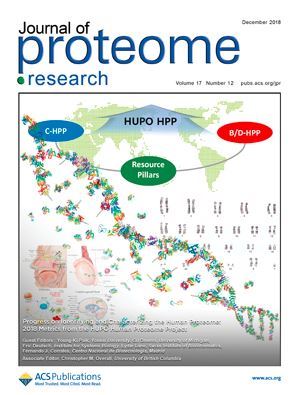Péter Horvatovich, University of Groningen, The Netherlands
 The Journal of Proteome Research Special Issue 2018 (Associate Editor: Christopher M. Overall, Guest Editors: Paik, YK, Eric Deutsch, Fernando Corrales, Lydie Lane and Gil Omenn) was published on December 7, 2018 (Volume 17, Issue 12). In this issue, a total of 32 papers covered 4 major research topics: (i) missing proteins (MPs), (ii) uPE1 proteins, (iii) bioinformatics tool development and (iv) biology/disease proteomes. According to the article summarising the progress on identification status and metrics of the Human Proteome Project, the number of missing proteins (PE1+2+3+4) decreased from 2579 to 2186 and the number of proteins with sufficient evidence at proteome level (PE1) reached 17470, which represents 89% of the human proteome, while the number of dubious proteins is 574. From the 17470 PE1 proteins there are mass spectrometry evidence in the Peptide Atlas for 15798 proteins. The launch of the neXt-CP50 pilot project to find at least one function of well identified 1260 PE1 proteins with unknown function (uPE1 proteins) using state-of-the-art gene editing technologies such as CRISPCas or gene silence with miRNA is discussed in Young-Ki Paik et al. Deutsch et al discusses all aspects of the use of spectral libraries and spectral library search in proteomics workflows including quality at library, spectra and peak (fragment ion) levels the used spectral similarity methods, construction of consensus spectra and merging different spectral library following the discussion at the 2017 Dagstuhl Seminar on Computational Proteomics. The work of Macron et al. describe identification of missing proteins in human cerebrospinal fluid following immunodepletion and TMT labeling. This work identified 12 missing proteins candidates from which 8 proteins were identified based on 2 to 6 uniquely mapping peptides and 4 matched a new peptide with a complementary “stranded” single peptide in PeptideAtlas from previous CSF studies. Sun et al. presents a study on human testis, using multiple proteases and high and low pH deep proteomics analysis and identified 14 PE2 MPs after spectrum quality analysis, isobaric post-translational modification, and single amino acid variant filtering, and synthesized peptide matching, from which 3 was testis specific. The study by He et al. used LysargiNase, the trypsin “mirror protease” that cuts before lysine and arginine equally as efficiently as trypsin that cuts after the basic residues, to identify low molecular weight missing proteins and validated 2 MPs from 7MPs candidates. Pullman et al. presented the tool ProteinExplorer, which allows to explore the large amount of reanalysed public proteomics data available in MASSIVE, which allowed to build a spectral library containing 2.1 million precursors matching to 1 million unique peptides and 19000 proteins. The use of ProteinExplorer allowed to validate HPP-compliant evidence for 107 MPs (PE2, PE3, and PE4) and 23 dubious (PE5) proteins.
The Journal of Proteome Research Special Issue 2018 (Associate Editor: Christopher M. Overall, Guest Editors: Paik, YK, Eric Deutsch, Fernando Corrales, Lydie Lane and Gil Omenn) was published on December 7, 2018 (Volume 17, Issue 12). In this issue, a total of 32 papers covered 4 major research topics: (i) missing proteins (MPs), (ii) uPE1 proteins, (iii) bioinformatics tool development and (iv) biology/disease proteomes. According to the article summarising the progress on identification status and metrics of the Human Proteome Project, the number of missing proteins (PE1+2+3+4) decreased from 2579 to 2186 and the number of proteins with sufficient evidence at proteome level (PE1) reached 17470, which represents 89% of the human proteome, while the number of dubious proteins is 574. From the 17470 PE1 proteins there are mass spectrometry evidence in the Peptide Atlas for 15798 proteins. The launch of the neXt-CP50 pilot project to find at least one function of well identified 1260 PE1 proteins with unknown function (uPE1 proteins) using state-of-the-art gene editing technologies such as CRISPCas or gene silence with miRNA is discussed in Young-Ki Paik et al. Deutsch et al discusses all aspects of the use of spectral libraries and spectral library search in proteomics workflows including quality at library, spectra and peak (fragment ion) levels the used spectral similarity methods, construction of consensus spectra and merging different spectral library following the discussion at the 2017 Dagstuhl Seminar on Computational Proteomics. The work of Macron et al. describe identification of missing proteins in human cerebrospinal fluid following immunodepletion and TMT labeling. This work identified 12 missing proteins candidates from which 8 proteins were identified based on 2 to 6 uniquely mapping peptides and 4 matched a new peptide with a complementary “stranded” single peptide in PeptideAtlas from previous CSF studies. Sun et al. presents a study on human testis, using multiple proteases and high and low pH deep proteomics analysis and identified 14 PE2 MPs after spectrum quality analysis, isobaric post-translational modification, and single amino acid variant filtering, and synthesized peptide matching, from which 3 was testis specific. The study by He et al. used LysargiNase, the trypsin “mirror protease” that cuts before lysine and arginine equally as efficiently as trypsin that cuts after the basic residues, to identify low molecular weight missing proteins and validated 2 MPs from 7MPs candidates. Pullman et al. presented the tool ProteinExplorer, which allows to explore the large amount of reanalysed public proteomics data available in MASSIVE, which allowed to build a spectral library containing 2.1 million precursors matching to 1 million unique peptides and 19000 proteins. The use of ProteinExplorer allowed to validate HPP-compliant evidence for 107 MPs (PE2, PE3, and PE4) and 23 dubious (PE5) proteins.


.png)